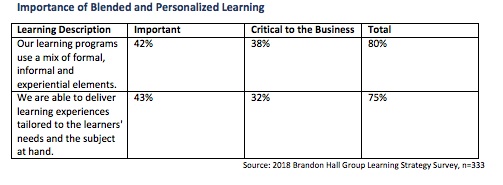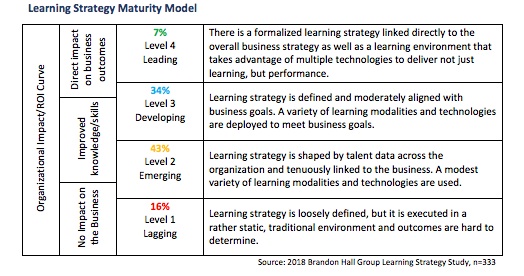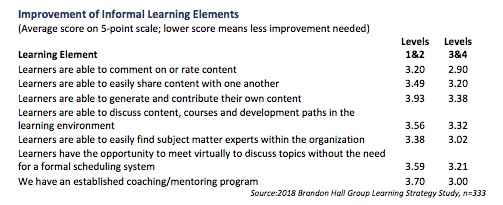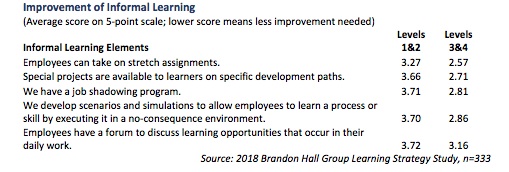
The increasingly rapid advance of technology is speeding up the way companies do business, and creating an environment in which organizations are able to deliver more flexible, continuous learning experiences. No longer bound to only the classroom or e-learning, it is becoming easier to create experiences that better fit the ways people learn. This approach also enables learning to keep up with the pace of the business, adapting to ever-changing needs. The shift is on—companies are recognizing the importance of delivering more informal and experiential learning, according to the 2018 Brandon Hall Group Learning Strategy Study.

This has all led to a much broader definition of blended learning. In the past, it referred to a combination of the only two delivery types available: classroom instructor-led training and e-learning course. In the modern learning ecosystem, there are far more types of experiences available. In fact, looking at the 70:20:10 framework, which posits that only 10 percent of what people learn comes from formal experiences, traditional blended learning falls almost entirely within that 10 percent. Now, the learning environment has shifted to a type of blend that also incorporates the other 90 percent.
For a clear majority of companies, it has become increasingly important to deliver not only this type of blended learning, but also learning experiences more tailored to the learners’ individual needs.

The importance of these concepts becomes clearer when we see that high-performing organizations are more effective at executing them than other companies. For example, 52 percent of high performers say they are either effective or highly effective at delivering tailored learning experiences, while only 30 percent of other companies say the same. To execute, it is important to first understand the different learning types and what they look like within the modern learning environment.
To better understand the attributes of modern formal learning, we can focus on organizations with robust, leading learning strategies in place, and compare their strategies to those whose strategies may still be somewhat lagging. In our research, the breakdown of learning strategies looks like this:

Formal Learning
The advances in technology and focus on more informal and experiential learning by no means signal the end of formal learning. In fact, classroom ILT is currently the No. 1 learning delivery method and will remain so for the foreseeable future. ILT and e-learning will remain integral, foundational parts of the learning environment. However, these formal learning experiences also must change and adapt to better meet the needs of the modern learner.
The biggest challenge with ILT is that it often is delivered as a lecture, or “death by PowerPoint.” Also, in most cases, learners are coming into the class cold, with no familiarity with each other, the instructor, or the subject at hand.
In a truly blended environment, information and subject matter can be conveyed through videos or other materials prior to the event. At the same time, participants can communicate and collaborate with one another through social networks dedicated to the class. This way, learners come to the ILT event on an even playing field, ready to put their knowledge to work.
The classroom then can be a far more interactive and collaborative event. The instructor becomes a facilitator, helping learners work their way through scenarios and exercises as they work together. If the learners are already familiar with one another, they are far more likely to interact from the outset.
When we look at companies from Levels 3 and 4 in the maturity model, we see they do a better job when it comes to effective classroom experiences than companies with less robust learning strategies.
Approximately 31 percent of companies in Levels 1 and 2 need significant improvement in this area, compared to 16 percent of Levels 3 and 4. The more advanced companies are also twice as likely to say they need no improvement.
The other main element in formal learning is e-learning. Although e-learning changed the learning landscape forever when it arrived, it has succumbed to its own success and become a lumbering catch-all for any non-ILT learning. Courses became the equivalent of lectures, with hours of mindless click throughs and slides. They have gotten infinitely better in recent years, with more interactivity and engagement, but there has always been a challenge with accessibility. E-learning catalogs have been notoriously hard to navigate, and most legacy content does not work on devices other than a desktop computer.
This is an area where Level 3 and 4 organizations are far ahead of their counterparts. Level 1 and 2 organizations are more almost twice as likely as Levels 3 and 4 to say their content navigation and access need a total overhaul. Only 3 percent of the lower-level companies say they do not need to improve their e-learning catalog, and 36 percent say it needs total improvement. Ease of use and accessibility are huge factors in learning adoption and effectiveness. An effective modern learning environment needs resources learners can access quickly, when and where they need them.
Informal Learning
Even though it accounts for just 20 percent of learning in the 70:20:10 model, informal learning covers a wide array of technologies, modalities, and experiences. Essentially, it is about the things we learn via our relationships. Whether it is the relationship with fellow learners, co-workers, instructors, or subject matter experts, it typically involves what we learn from others outside of a formal experience. This means a focus on collaboration, connections, and coaching.
Again, companies with more mature learning strategies do a much better job of fostering this type of learning. Using the same 1-to-5 scale of needing no improvement to needing total improvement, we can see that higher-level companies have lower average scores for a variety of informal learning elements (which means they need less improvement).

These elements are also critical to the success of formal learning experiences. Without the ability to communicate and collaborate, much of the knowledge derived from formal learning can be lost and forgotten. Ongoing informal connections keep the learning active, retained, and even expanded.
Experiential Learning
The biggest piece of the 70:20:10 framework, experiential learning, is ironically the hardest one for organizations to wrap their arms around. The truth is, it would be foolish to think a company can use tools and technologies to meet a learner’s entire experiential learning needs. Experiential learning is the learning that happens all day, every day. People learn by observing others, trying things themselves, and picking up ideas from all around them. The goal is not to structure this, but rather to recognize it and facilitate it to the best of our abilities. To that end, experiential learning is the area where higher-level companies are most separated from the rest. Companies with mature strategies do a much better job at enabling this type of learning within the confines of the tools available to them. In each case, Level 3 and 4 companies need far less improvement than Level 1 and 2 companies—typically far less.

Experiential learning is really about the “show me” and “let me” parts of “tell me, show me, let me” learning. You can tell someone how to do something through a course or a class, but they perform better when they are shown how to do it—through observation or job shadowing—and then able to do it themselves—through scenarios, simulations, special projects, etc. It is a critical piece of learning that the Learning function traditionally has been unable to master, simply because there really haven’t been many tools available to facilitate, track, and measure it. The modern learning environment is changing that.
Key Takeaways
- Formal learning is not the enemy. Class and course experiences typically form the core of the learning environment, with the other elements working in and around them. Don’t abandon them; rethink them through the lens of modern learning strategy.
- Keep learners connected. The most powerful source of knowledge in an organization is typically the employees themselves. Let them share experiences and learn from one another, the way people learn in their lives outside of work.
- Knowledge is nothing without execution. Creating opportunities for learners to put their new skills and behaviors to work is part of the learning process. People are sometimes hesitant to try new things in the real world without practicing at least somewhat prior.
- Don’t get caught up in how much of which type of learning to provide. Every outcome may require a slightly different approach. A learning strategy that is flexible and allows for an iterative learning program allows learning to become as agile as the rest of the organization.
David Wentworth is principal Learning analyst at Brandon Hall Group, an independent research/analyst firm in the human capital management market. The firm’s vision is to inspire a better workplace experience, and its mission is to empower excellence in organizations around the world through its research and tools. Brandon Hall Group has five HCM practices, and produces the Brandon Hall Group Excellence Award; the Women in Leadership Summit, June 6-7 in Fort Lauderdale, FL; and the annual HCM Excellence Conference, held Jan. 22-25, 2019, in West Palm Beach, FL.




